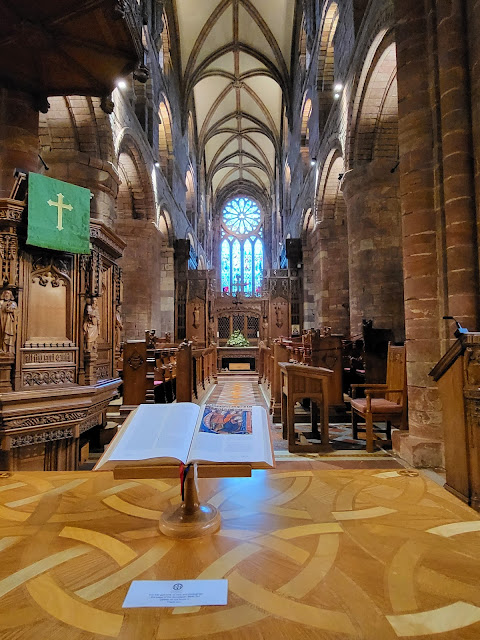We're not done with Orkney quite yet. This will be the last post about my time there but I wanted to talk about the wonderful St Magnus Cathedral and a couple of other places I visited.
I've been to many a cathedral in my time and truthfully, I'm pretty much done with them. Not being religious I don't find them spiritual nor do they have any deep meaning to me but I do admire the architecture and the history. Plus they are a good place to sit down, have a rest and a quick check of my guidebook or map!!
However, St Magnus is pretty special as it was originally constructed by Norsemen. St Magnus Cathedral was founded in 1137 by Earl Rognvald, the nephew of St Magnus. When first built the cathedral was part of the Archdiocese of Nidaros (now Trondheim) in Norway. Orkney became part of Scotland in 1468 and the cathedral was gifted to the people of Kirkwall by the Scots king, James III. (this blurb is from the official St Magnus brochure)
Why was St Magnus built? It is a very interesting story. Magnus Eriendsson was the Earl of Orkney in the early 1100's. He shared the Earldom with his cousin Hakon but they did not get on and Orkney suffered as a result. To settle the dispute Hakon and Magnus held a meeting on the island of Egilsay. Hakon broke the agreement to bring unarmed men, instead arriving with eight ships of armed men. (tosser!!) Rather than kill Magnus himself, Hakon ordered his cook Lifolf to do the deed. Magnus died praying, killed by an axe to the head. He was buried in Birsay and stories grew of miracles at his grave. People began to believe that Magnus was a holy man. (This came from the official brochure as well; except for the tosser comment!) Magnus' nephew Rognvald came from Norway to claim his uncle's Earldom. He built the cathedral in homage to his Uncle Magnus. The remains of St Magnus were brought to Kirkwall followed a few years later by those of Rognvald who was killed in 1158. The bones of both men lie within the walls of the choir.
After the Scottish Reformation in 1560 the cathedral became a Protestant church but today it belongs to the people of Orkney and can be used by any denomination. The cathedral is referred to as "The Light in the North".
The three statues were carved in 1965 by Oracadian artist Stanley Cursiter. They depict Kol Kallison (Rognvald's father), Rognvald (holding the cathedral) and William the Old who was the Bishop of Orkney when the cathedral was built.
Can you see the Green Man's face?
This is a memorial to Dr John Rae, the explorer. Remember him? He is buried in St Magnus churchyard with a very modest tombstone - I failed to find his grave.
There were many headstones along the walls. They once covered burials but the remains were exhumed and reburied in the graveyard. Skull and crossbones are a common feature on old gravestones.
On my last day on Orkney I headed out of town again. On the way the bus passed over the Churchill barriers which are four causeways linking the mainland (what they call the main island) to Burray and South Ronaldsay. These were constructed during World War II as a defense against enemy attacks - work began in 1940 and they weren't officially opened until just after the war ended. Most of the work was done by Italian Prisoners of War who were captured in Libya and taken to Orkney.
Here is one of the barriers/causeways.
These are the remains of hulks of sunken ships. Hundreds of ships were deliberately sunk to provide a defense barrier between the islands however a Nazi submarine was able to find a gap in the defense and sunk the HMS Royal Oak in Scapa Flow. This was when it was decided to build a more permanent defense and construction on the Churchill Barriers began. Scapa Flow was used as the main base of the British Home Fleet. Up to 40,000 men were based in Orkney during the peak of activity in World War II so it was imperative that it was kept safe.
As I was taking the overnight ferry to Shetland a few hours later I was appreciative of a good meal like this. I almost licked the plate clean.
In late 1943 two Nissan huts were laid end to end. One end was to be a chapel and the other a school. Chiochetti and a small number of other POWs worked on the chapel. Chiocchetti painted the Madonna and Child from a card given to him when he left for the war. Palumbo, a POW and metalworker by trade made the candelabra, rood screen and gates.

































Comments